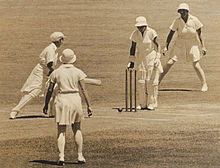Australia women's national cricket team
Currently captained by Alyssa Healy[8] and coached by Shelley Nitschke,[9] they are the top team in all world rankings assigned by the International Cricket Council (ICC) for the women's game.A rich history with New Zealand stretches back almost as far while strong rivalries have also developed more recently with India and the West Indies, manifesting predominantly via limited overs cricket.Following two losses, Australia eked out a draw in the third Test at the MCG with the spin bowling duo of Anne Palmer and Peggy Antonio proving to be among the team's standout performers.Having already affirmed herself as a star of the team with a ten-wicket haul and an innings of 90 against New Zealand,[25] all-rounder Betty Wilson led Australia to a 186-run victory in the first Test of the 1948–49 series over England, claiming match figures of 9/62 as well as scoring a century.Though Wilson contributed key runs and wickets as anticipated, it was ultimately the all-round performance of fast bowler Norma Whiteman (who finished the match with a defiant knock of 36 not out) which guided the team across the line.[31][32] Australia became a member of the International Women's Cricket Council (IWCC) at its inception in 1958, helping to form the governing body alongside England, the Netherlands, New Zealand and South Africa.[36] However, the broader development and support of women's cricket began to soar once more due to the pivotal roles of a handful of dedicated players and administrators, especially through their efforts in schools and junior clubs.[35] India paid a maiden visit in 1976–77, playing one Test match in Perth which resulted in Australia's first victory in the longest form of the game in nearly two decades, marking the beginning of the team's turnaround.Captain Margaret Jennings led the team in its triumphant campaign while Sharon Tredrea had a significant impact with bat and ball throughout the tournament which was held in India before crowds of up to 40,000 people.While several core group members, such as Lyn Larsen and Denise Annetts, retired from international cricket at the conclusion of the tournament or soon after, the next generation of stars had already begun to cement themselves at the top level—most famously Belinda Clark and Zoe Goss.[54] The following year, Goss also helped spark an unprecedented amount of attention around the women's game when she dismissed Brian Lara during a charity match at the Sydney Cricket Ground.A biomechanics expert by trade, Harmer advocated for an exciting and enjoyable approach from his players: "After my first tour of New Zealand, I took them aside and said, 'This is so boring, sitting here, watching you lot play.Not only did they defeat Denmark by 363 runs (which included a record innings of 229 not out by Belinda Clark) and bowled out Pakistan for 27,[59][60] they also chased down totals set by England and South Africa with half-an-innings to spare.[65] Triumphant captain Clark has cited the scenes in the aftermath of the match as a career highlight: "Our victory lap is still etched in my memory, because we were being cheered like a home team.The following year, the Commonwealth Bank became a sponsor of the national women's team after the daughter of CEO David Murray participated in a school clinic (run by Belinda Clark) and became enamoured with cricket.Shelley Nitschke and Lisa Sthalekar proved to be invaluable all-round additions to the team, while Karen Rolton became the first player to score a century in the knockout stage of a Women's Cricket World Cup by making 107 not out in the final against India.[73] The IWCC was officially integrated with the International Cricket Council (ICC) after the 2005 World Cup, promising to result in "greater media exposure and publicity" for the women's game than ever before.[77] Rolton's tenure oversaw a challenging transition period in the team's history as the careers of several players from the '90s zenith line-up came to a close—in particular, Cathryn Fitzpatrick made her last appearance for Australia in the final of the 2006–07 Quadrangular Series.[79][80] Searching to fill the immense void left by the departure of their premier fast bowler, selectors looked to the future by turning to a 16-year-old Ellyse Perry who would play her first ODI for the team in July 2007.Opposition batter Sophie Devine struck a powerful straight drive back down the pitch, threatening to result in a match-tying four runs, but Perry instinctively stuck out her right foot and successfully stopped the ball from reaching the boundary.Due to timely contributions with the bat, Jess Duffin garnered a reputation as a big game performer during the first two of the three events, earning Player of the Final honours on both occasions.[102][103] Despite winning both limited overs legs of the series, Australia still missed out on regaining the trophy due to losing the Test match, prompting a tweak to the points system for future editions.Jess Jonassen starred with the bat while Ellyse Perry tore through the English line-up with the ball on the last day of play to help record a 161-run victory.[115] With Lanning set to miss the 2017–18 Women's Ashes, Rachael Haynes stepped in as acting captain and the team retained the trophy via an inconsistent performance across the drawn series.They proceeded to win the 2018 World Twenty20, held in the West Indies, with a comprehensive defeat of England in the final which followed a dominant bowling and fielding display throughout the campaign as well as a Player of the Tournament performance by wicket-keeper Alyssa Healy.[128] An early loss to India, a scare against underdog Sri Lanka, and a mounting list of injuries to key players ensured Australia's road to the final would not be easy.With the team claiming a seventh 50-over title and winning 40 of 42 ODIs since their shock semi-final exit in 2017,[146] cricket.com.au's Laura Jolly said the triumph was "the crowning moment of a five-year journey of redemption".Arguably the most memorable moment of the campaign came in the semi-final against India when Australia pulled off a "remarkable fightback with the ball"[153] to secure a five-run victory which Meg Lanning described as "one of the best wins I have been involved in.[155][156] The existence and subsequent extinction of the now-infamous culottes, paired with the players previously having to pay out of their own pocket for the unfortunate fashion trend, has been cited as a symbol of the shift from the amateur to professional era in women's cricket.The program is conducted over a twelve-month period in which the athletes attend approximately three camps per year at the National Cricket Centre and undergo specialist training sessions within their home state.






Australia national cricket teamCricket AustraliaAlyssa HealyShelley NitschkeInternational Cricket CouncilFull memberEast Asia-PacificWomen's TestsEnglandBrisbane Exhibition GroundBrisbaneMelbourne Cricket GroundMelbourneWomen's One Day InternationalsYoung EnglandDean Park Cricket GroundBournemouthBellerive OvalHobartWomen's World CupWomen's Twenty20 InternationalsCounty Ground, TauntonAdelaide OvalAdelaideWomen's T20 World Cupwomen's cricketTest match1934–35Women's AshesNew ZealandWest Indieslimited overs cricketWorld CupsTwenty20 cricketICC Women's T20 World CupWomen's National Cricket LeagueWomen's Big Bash LeagueWomen's cricket in AustraliaBendigotouring in the summer of 1934–35Margaret Pedenspin bowlingAnne PalmerPeggy Antoniomaiden overseas voyage in 1937leg spinnerKath Smithall-roundThe OvalBetty WilsonAustralia visited New Zealand for the first timefollowing summerten-wicket haulcenturyWorcesterMollie DiveNorma Whitemannot out1957–58 seriesJunction OvalFaith ThomasIndigenous personInternational Women's Cricket Councilthe NetherlandsSouth AfricaMary AllittMedal of the Order of AustraliaJames SutherlandLorna ThomasWorld CupOne Day InternationalLord's1976–771978 World CupMargaret JenningsSharon Tredrea1982 World CupJill KennareLyn Fullstonnetballleft-arm orthodoxJess JonassenEllyse PerryJess DuffinEnglish team toured in 1984–85Queen Elizabeth OvalRaelee ThompsonDenise Emersonthree-peat1988 World Cuprate of scoring1993 World CupLyn LarsenDenise AnnettsBelinda ClarkZoe GossBrian LaraKaren Rolton1996–97Australian Women's Cricket ChampionshipsCommonwealth BankCathryn Fitzpatrick1997 World CupDenmarkPakistanEden Gardens1997–98 New Year's TestLisa Sthalekarthe Women's Ashesthe male equivalentJoanne BroadbentMichelle GoszkoNew Zealand CricketEngland and Wales Cricket Board2005 World Cup2000 World CupTauntonTwenty20 International2009 World Cup2006–07 Quadrangular Seriesnational women's soccer teaminaugural Women's T20 World Cup2009 Women's AshesJodie Fields2010 World Twenty20Sophie Devine